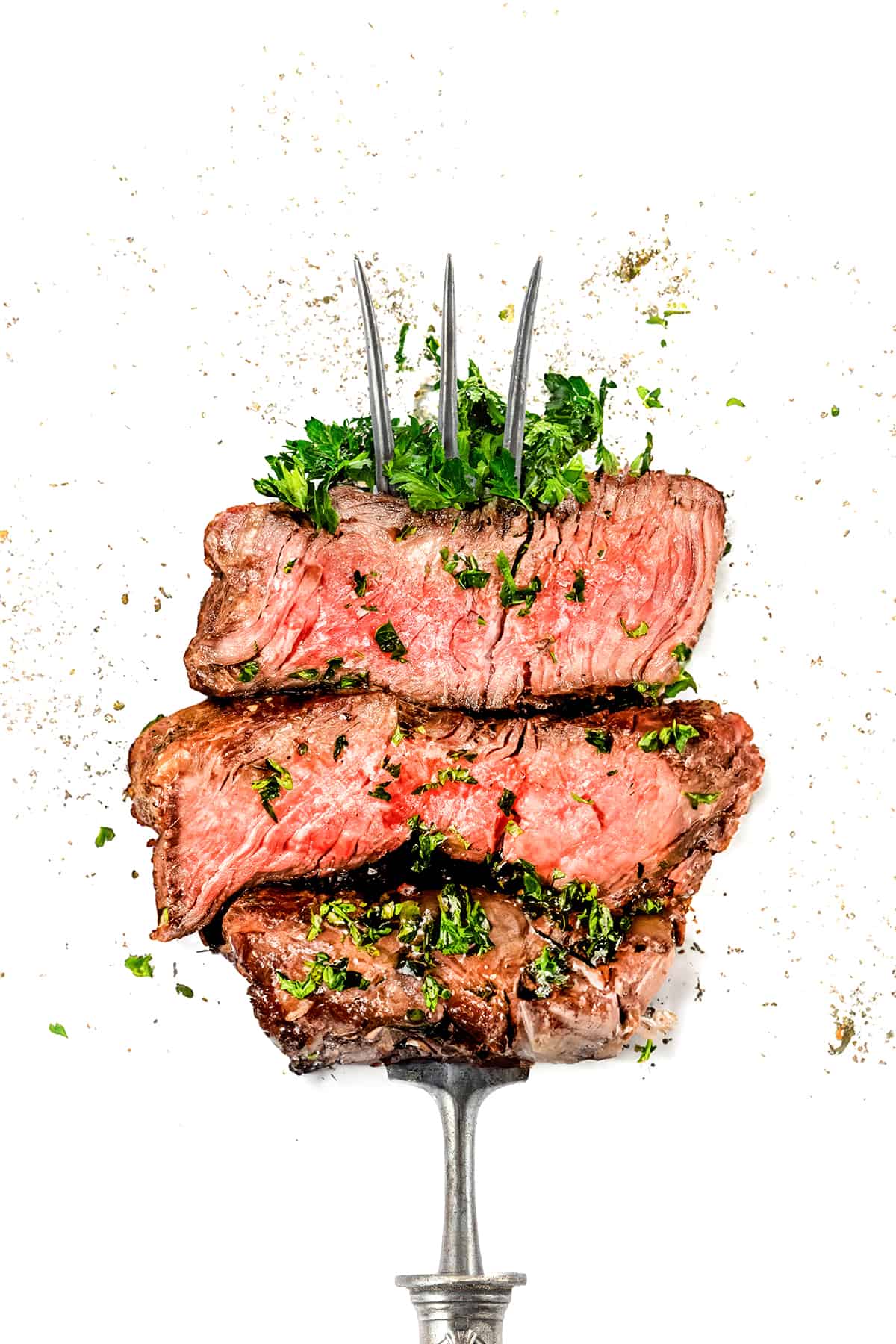
This site runs ads and generates income from affiliate links. Read my disclosure policy.
Grilled Filet Mignon steaks with a savory seasoning and buttery garlic basting. Tender, juicy, and full of flavor in every bite!
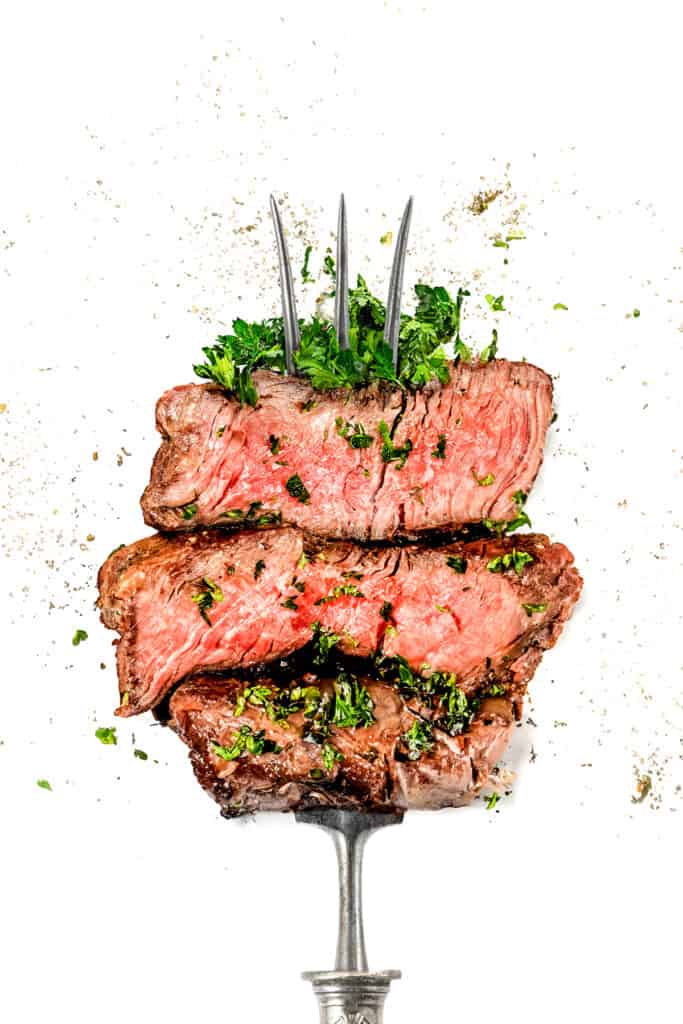
Indulge in the ultimate dining experience with this delectable Grilled Filet Mignon recipe. These mouthwatering steaks are seasoned to perfection, cooked to your desired level of doneness, and finished with a buttery garlic basting. Pair them with a luscious red wine sauce to elevate the flavors even further. Whether you’re hosting a special occasion or simply craving a luxurious meal, these grilled filet mignon steaks with a rich red wine sauce will impress. Follow this step-by-step guide always to achieve tender, juicy, and flavorful results.
Whether you’re a seasoned griller or a beginner, this post will provide you with all the information you need to make a mouthwatering steak. Below, you’ll find a table of contents to help you navigate the various sections. Feel free to jump to the specific topic you’re interested in or read through the entire post for a complete understanding of this delicious recipe.
Why This Recipe Works
- Tender and Juicy: The filet mignon steaks are known for their exceptional tenderness, making them one of the most coveted cuts of beef. The grilling method used in this recipe locks in the juices, resulting in a succulent and melt-in-your-mouth texture.
- Flavorful Seasonings: The combination of kosher salt, freshly ground black pepper, and minced garlic enhances the natural flavors of the filet mignon, adding a savory and aromatic touch to each bite.
- Butter Basting: The final touch of basting the steaks with melted butter and garlic infuses an irresistible richness, elevating the overall taste and providing a luscious mouthfeel.
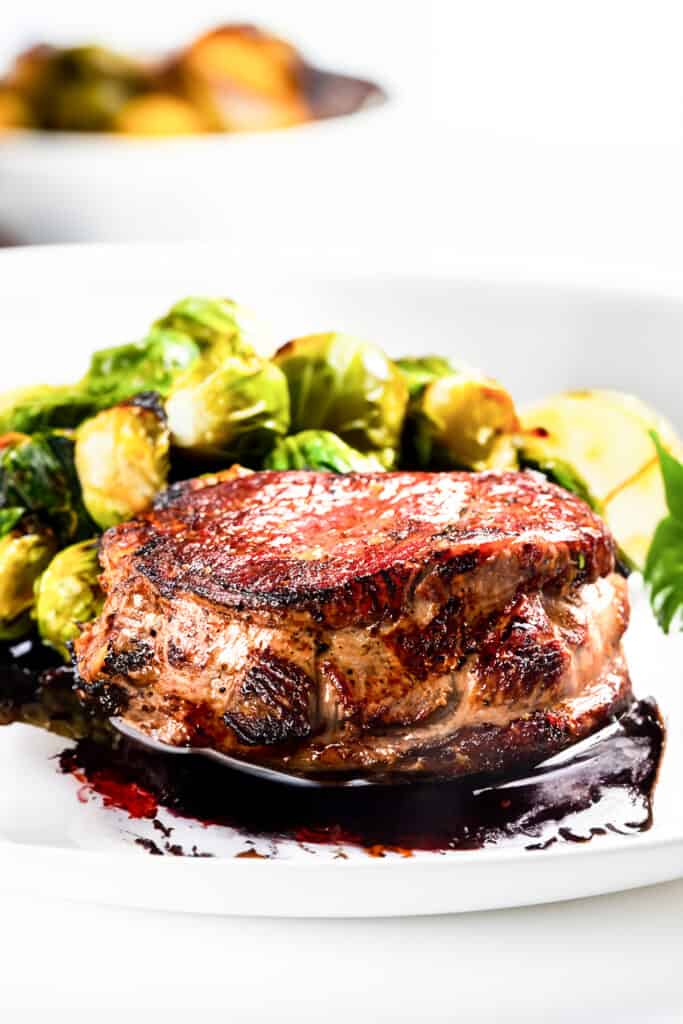
Ingredient Notes
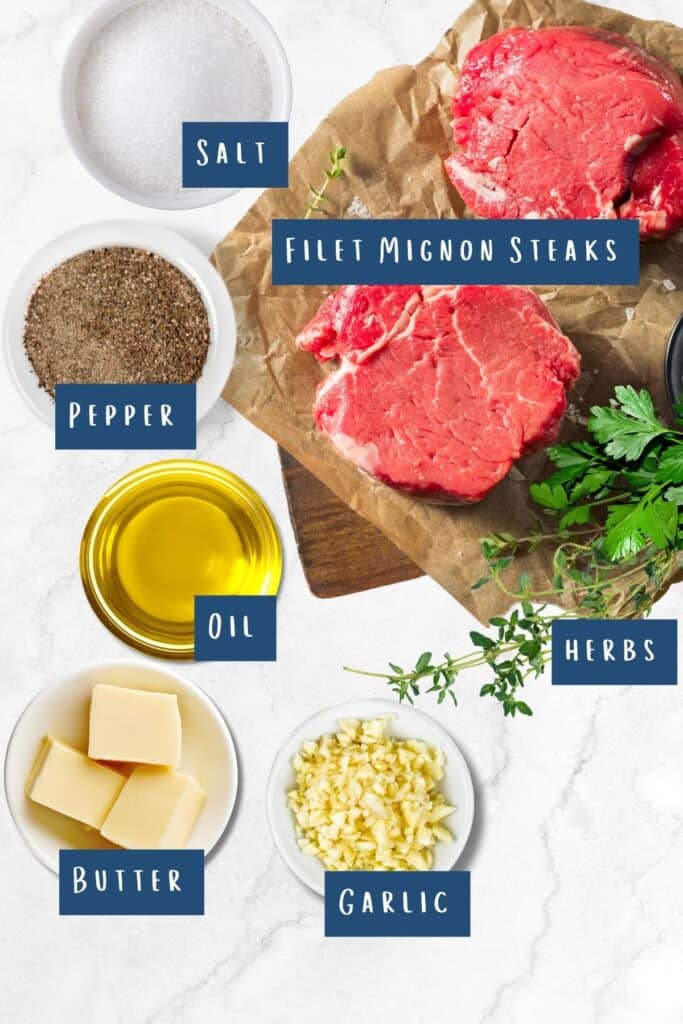
- Filet Mignon Steaks: Choose high-quality filet mignon steaks, preferably with good marbling. Look for steaks that are approximately 6-8 ounces each.
- Kosher Salt: Use kosher salt to season the steaks generously, enhancing their flavors. If unavailable, you can substitute with sea salt.
- Freshly Ground Black Pepper: Avoid adding pepper before grilling as it may burn. Instead, season the steaks with black pepper after cooking.
- Oil: Choose an oil with a high smoke point, like light olive oil (not EVOO), canola, vegetable, sunflower, or grapeseed oil. These oils can withstand high temperatures without burning and affecting the flavor of your steak.
- Garlic: Fresh cloves of garlic lend robust flavor. You can find garlic in the produce section of your grocery store.
- Fresh Herbs: We use a mixture of fresh thyme and parsley, but you can use rosemary, oregano, or whatever you like best. Opt for fresh herbs for the best aroma and flavor. Please find it in the fresh herbs section of your grocery store.
- Butter: Choose unsalted butter for this recipe, allowing you to control the saltiness. Salted butter can be used as a substitute if unsalted is not available.
Filet Mignon Buying Guide
When purchasing filet mignon steaks, visit your grocery store’s reputable butcher or high-quality meat section. Look for steaks that are well-marbled and evenly cut. Ensure the steaks are fresh and deep red, indicating their quality.
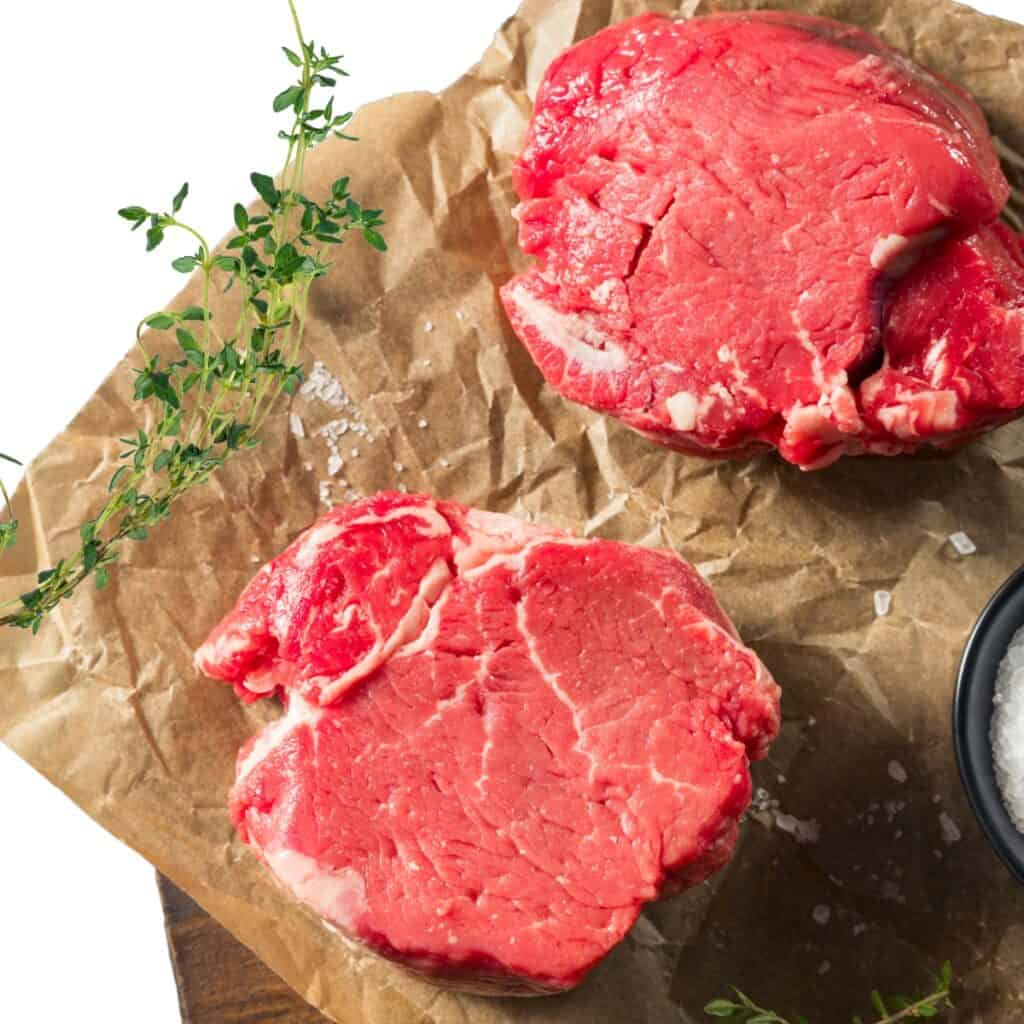
Choose steaks that are about 6 to 8 ounces each, providing a generous serving size.
Step By Step Instructions
Making The Butter Baste
Mix 4 tablespoons of unsalted softened butter in a small bowl with finely chopped herbs, such as rosemary, thyme, or parsley, and 2 to 4 minced garlic cloves. This herb-infused butter will add an extra layer of flavor to your grilled steak.
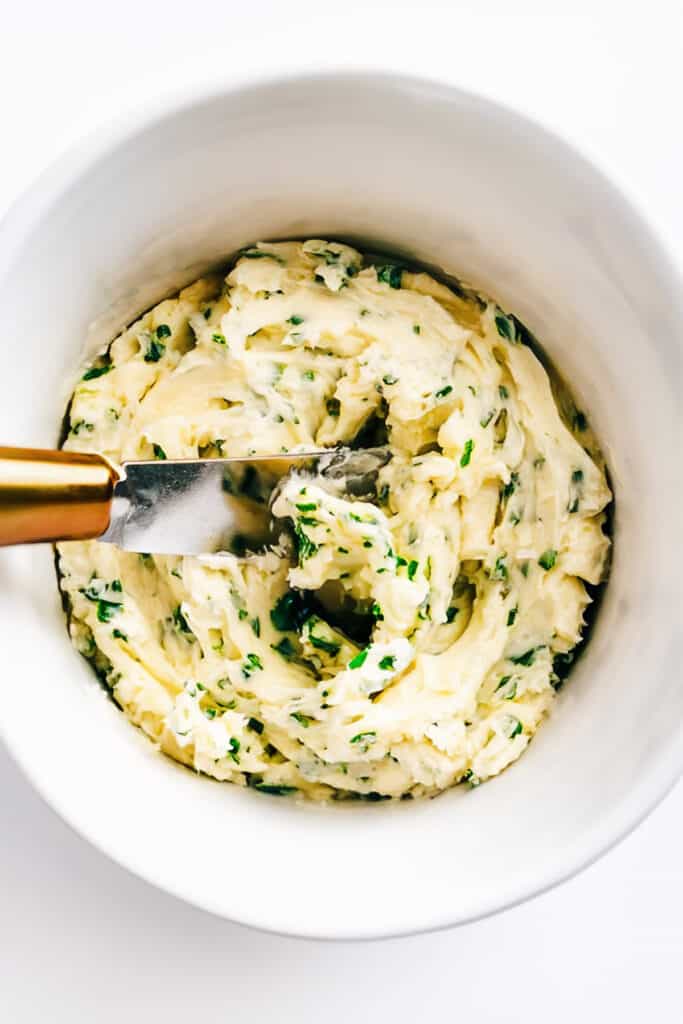
Preparing Filet Mignon for Cooking
Begin by taking the filet mignon steaks out of the fridge. Season all sides generously with kosher salt. Do not add pepper yet to prevent burning during grilling.
Salting the steaks early helps enhance their flavor. You can salt the steaks for up to 24 hours if they are thicker, as they need more time for the salt to penetrate and enhance the flavor. Thinner steaks can be done 1 to 2 hours before cooking.
Adding salt to the steaks before cooking gives the salt enough time to penetrate the meat, making it taste better. It also helps tenderize the steaks, making them juicier and more delicious. So, by salting early, you get steaks that are packed with flavor and perfectly seasoned.
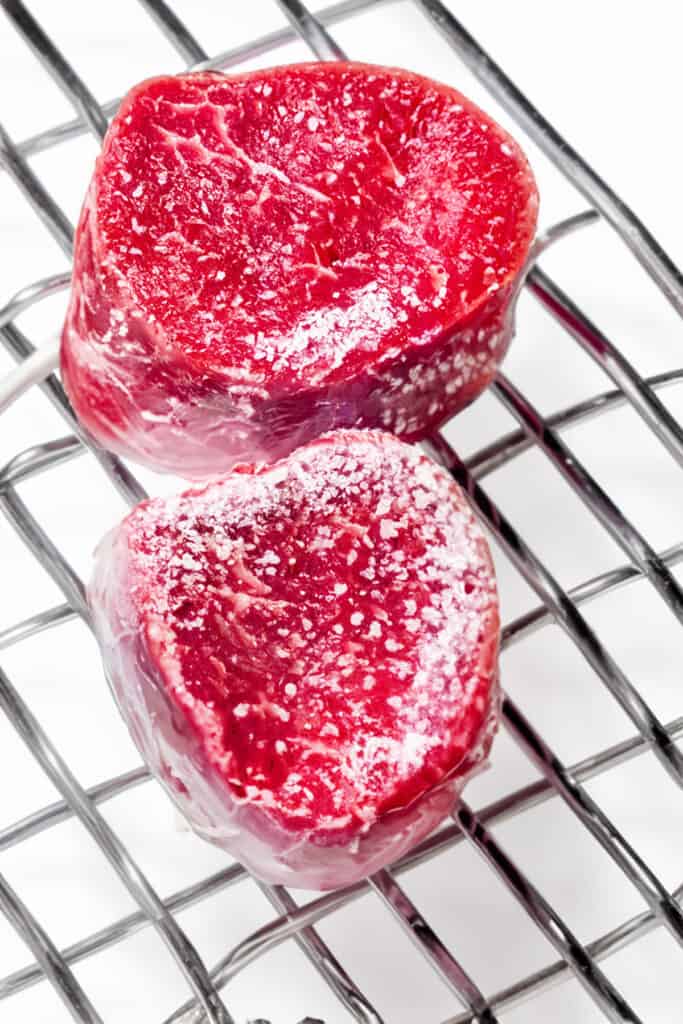
If the steaks are less than 2 inches thick, let them rest on a wire rack at room temperature for 1 to 2 hours.
Using a wire rack helps air circulate around the steaks, allowing them to come to room temperature more quickly and evenly.
For thicker steaks, refrigerate them for up to 24 hours. Remove them from the fridge about an hour before cooking to allow them to come to room temperature.
Place raw meat on the bottom shelf of the refrigerator to prevent any drips from coming into contact with other foods. This helps minimize the risk of cross-contamination.
Thicker steaks must be kept in the refrigerator to ensure the inside stays safe while the outside warms up. This helps cook the steak evenly. Thinner steaks don’t need as much time; about 1 to 2 hours at room temperature on a wire rack is enough.
It’s important not to cook steaks straight from the fridge because it can affect cooking time and make them cook unevenly.
Grilling Your Steaks
Preheat your grill to high heat. Pat the steaks dry with a paper towel to ensure a good sear. Rub olive oil on all sides of the steaks.
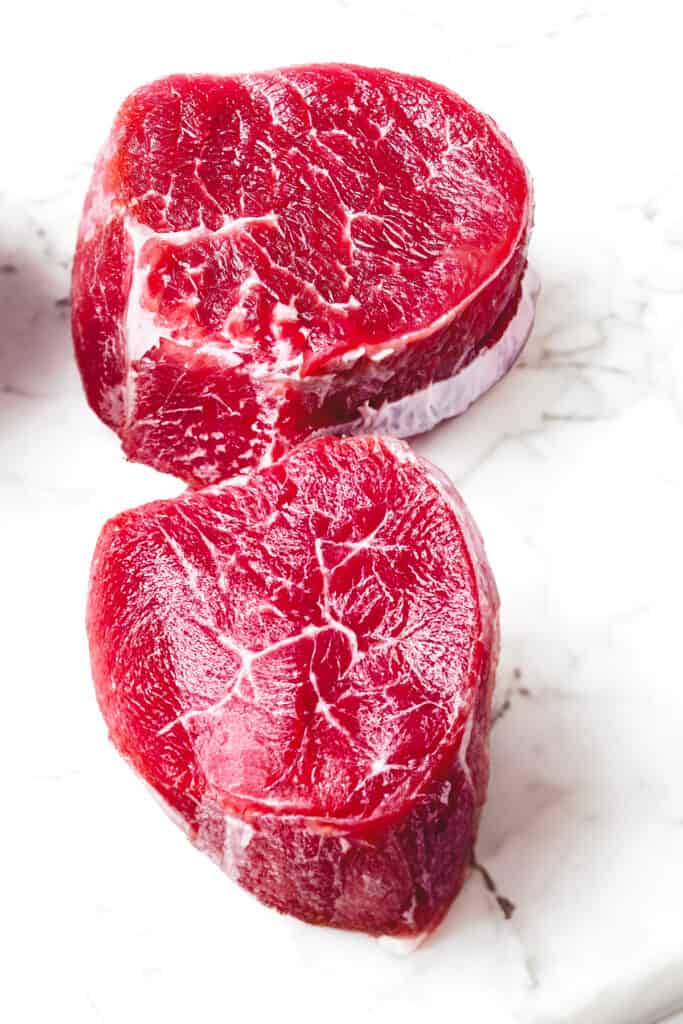
Place the steaks on the preheated grill, close the lid, and cook on one side for approximately 4 to 5 minutes to achieve a nice sear.
Flip the steaks over, close the lid, and continue grilling for another 3 to 4 minutes.
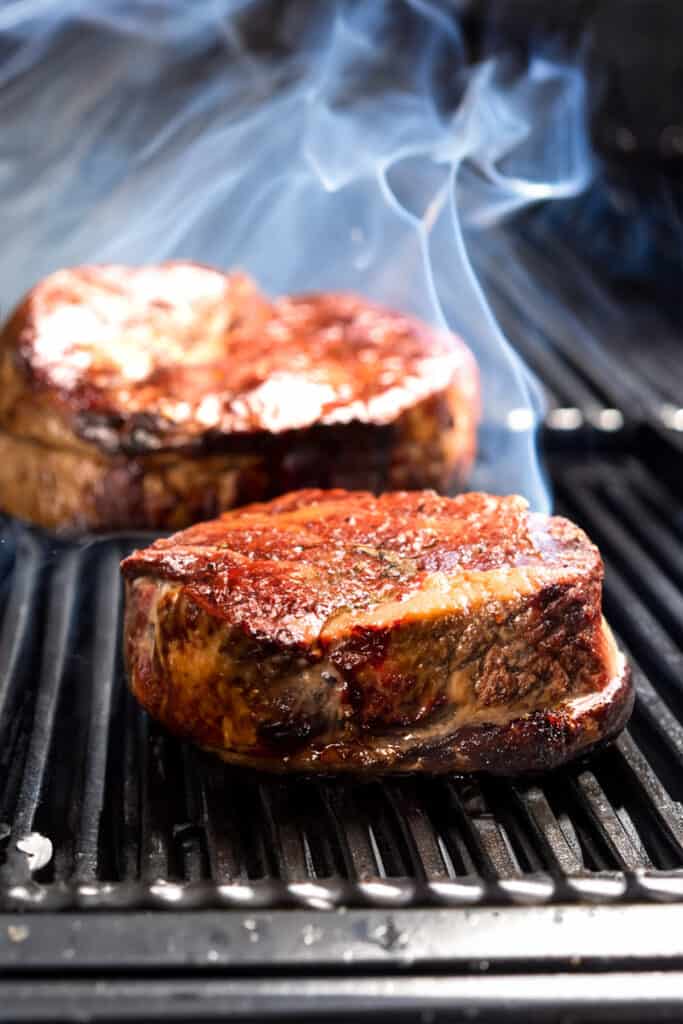
Add a tablespoon of the butter mixture to each steak in the last two minutes of grilling. Allow the butter to melt, and baste the steaks.
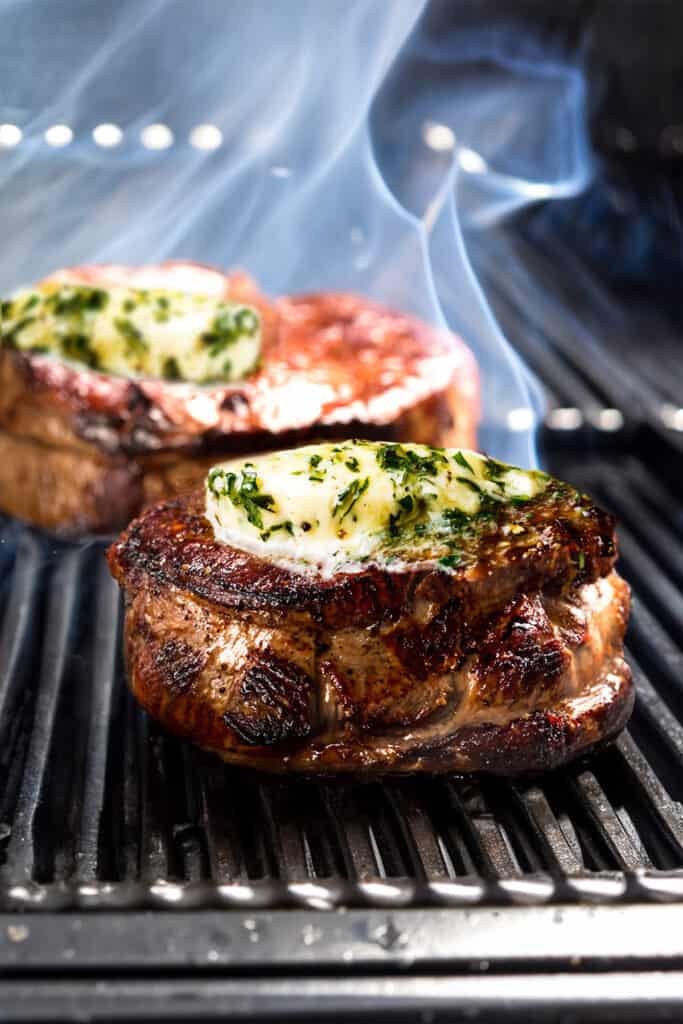
Aim for an internal temperature of 130 to 135°F (54-57°C) for medium-rare or 135 to 140°F (57 to 60°C) for medium, and remove the steaks from the grill (they will finish cooking while they rest).
Transfer the grilled steaks to a plate or cutting board, cover them loosely with foil, and let them rest until they reach an internal temperature of 135 to 140°F (54 to 60°C) for medium-rare or 140 to 145°F (60 to 63°C) for medium (5 to 10 minutes).
Once rested, serve the filet mignon steaks as they are or garnish them with additional herbs or seasoning if desired.
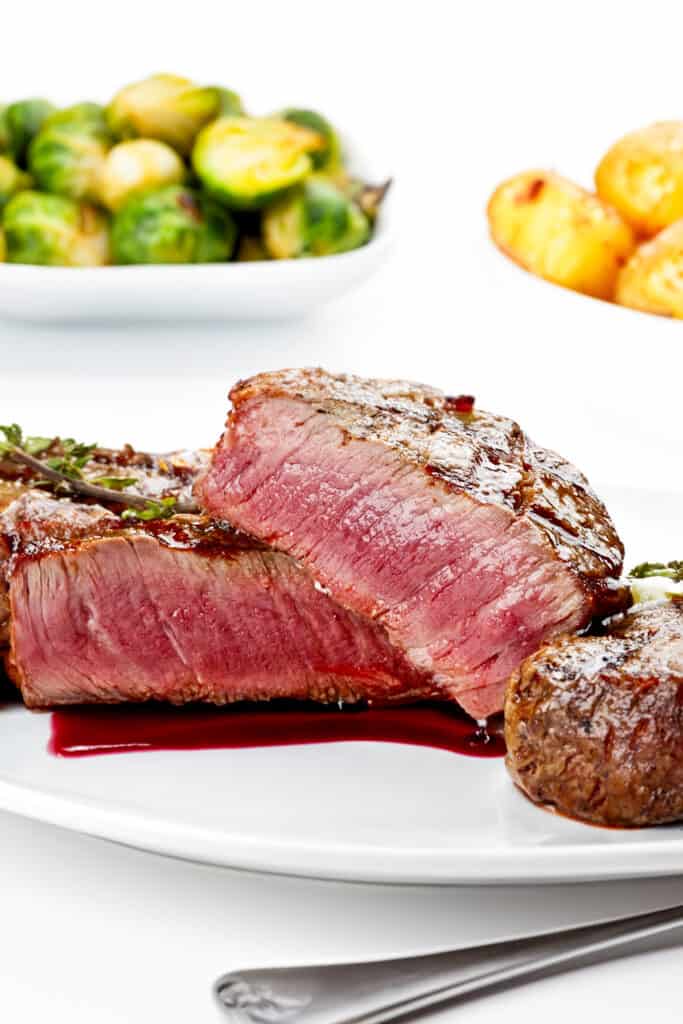
Filet Mignon Doneness Guide
Achieving the perfect filet mignon requires finding the right balance in cooking. You aim for a steak that is seared to perfection, tender, and full of juiciness without being overcooked or undercooked. To assist you in reaching your preferred level of doneness, here is a handy guide that will help you determine when your filet mignon is cooked just how you like it.
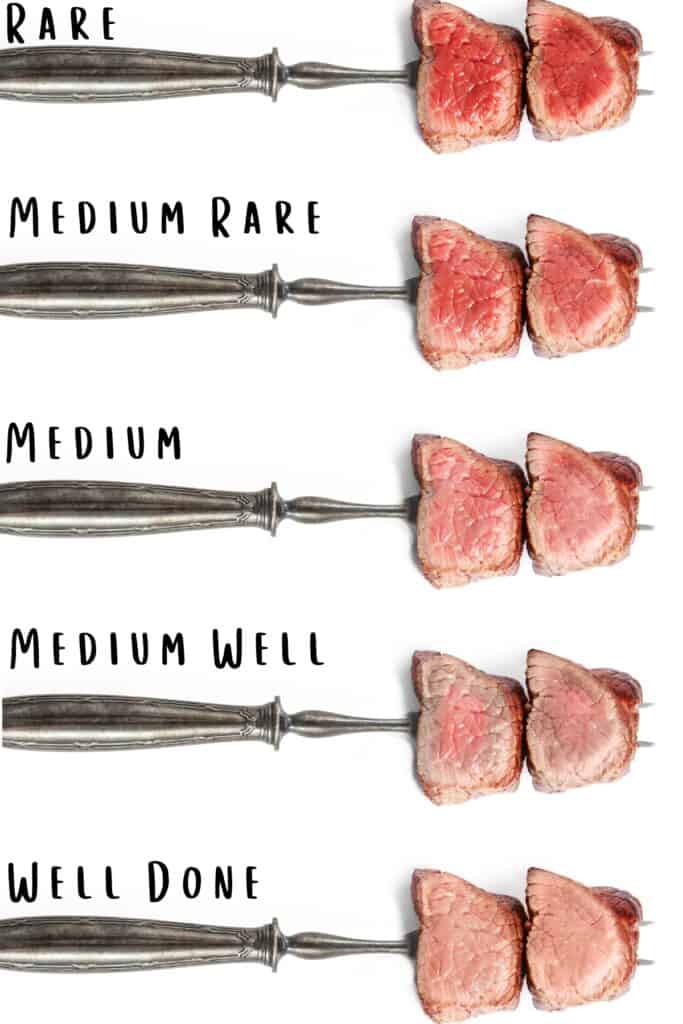
The simplest way to gauge the doneness is by using an instant-read thermometer. Just insert it into the thickest part of the steak, avoiding bones or fat. Wait for about 10 to 15 seconds, then check the temperature and refer to the table below to determine the level of doneness you prefer. This will help you cook a beautifully seared steak, juicy and perfectly cooked.
Filet Mignon Doneness & Temperatures
After cooking, the steak’s temperature will rise about five to ten degrees as it rests. To achieve your desired level of doneness, take the steak off the heat when it is about five to ten degrees below the preferred serving temperature. The steak will continue cooking from the residual heat (a process called carryover cooking).
To ensure the best outcome, follow the recommended temperature ranges below until the steak reaches your desired level. This typically takes around five to ten minutes. You can refer to the accompanying image for a visual guide.
If your top priority is food safety, cook the steak until it reaches a medium-well level of doneness.
| Doneness | Cook To Temperature | Resting Temperature |
|---|---|---|
| Rare | 125-130°F (52-54°C) | 135-140°F (57-60°C) |
| Medium Rare | 130-135°F (54-57°C) | 140-145°F (60-63°C) |
| Medium | 135-145°F (57-63°C) | 145-150°F (63-66°C) |
| Medium Well | 145-155°F (63-68°C) | 155-160°F (68-71°C) |
| Well Done | 160°F (71°C) or above | 165°F (74°C) or above |
Download the above Steak Temperature Table to print or save for later.
Erren’s Top Tips
- Choose an oil with a high smoke point, like light olive oil (not EVOO), canola, vegetable, sunflower, or grapeseed oil. These oils can withstand high temperatures without burning and affecting the flavor of your steak.
- If you’re grilling multiple filet mignon steaks, ensure your grill provides enough space between each steak. Allowing about two inches of space between them is essential to ensure even cooking. If your grill is too small for that, it’s best to cook them in batches rather than crowding them together.
- Use a meat thermometer to ensure your filet mignon is cooked to your desired level of doneness. This handy tool guarantees that your steaks are perfectly cooked and helps prevent overcooking. Refer to the steak doneness guide in the post for more information on desired temperatures.
- When searing your filet mignon, please resist the temptation to move or flip it frequently. Let the steak cook undisturbed to maintain constant contact with the grill. This will ensure a beautiful sear and caramelization on the surface of the steak.
Storage & Freezing Instructions
If you have leftovers, store the cooked filet mignon steaks in an airtight container in the refrigerator for up to 3 days.
To freeze, wrap each steak tightly with plastic wrap or place them in freezer-safe bags. They can be stored in the freezer for up to 3 months. Thaw them in the refrigerator overnight before reheating or consuming them.
The Perfect Pairings
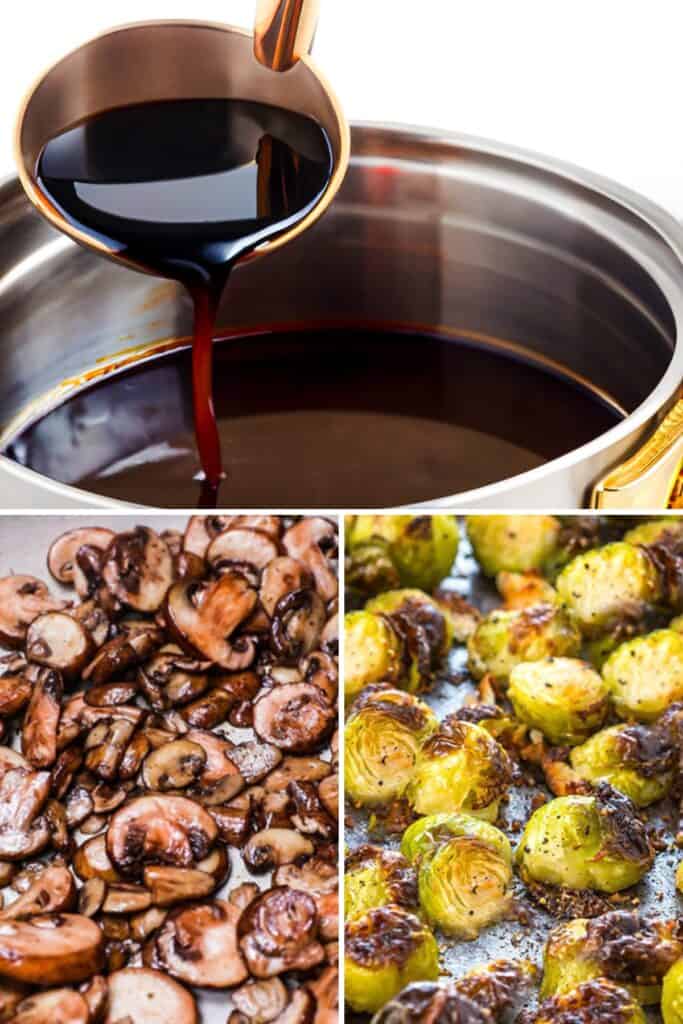
We Serve our filets with roasted Brussels sprouts, roasted potatoes, and red wine sauce, but your choices are endless! If you have a soft spot for mushrooms, our Easy Sautéed Mushrooms and Creamy Garlic Mushrooms make excellent steak toppings that complement the flavors perfectly. Our Burger Onions offer a delightful and flavorful option for those seeking a sweeter twist.
Rate This Recipe
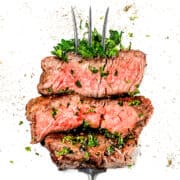
Recipe
Perfectly Grilled Filet Mignon
Ingredients
- 4 filet mignon steaks (approximately 6 to 8 ounces each)
- 4 tablespoons unsalted butter (softened)
- 4 cloves garlic (minced)
- 2 tablespoons fresh herbs (such as rosemary, thyme, or parsley, chopped)
- Kosher salt (to taste)
- 2 tablespoons olive oil
- Freshly ground black pepper (to taste)
Instructions
- In a small bowl, mix softened butter with finely chopped herbs and minced garlic. Set aside
- Take the filet mignon steaks out of the fridge. Season all sides generously with kosher salt. Do not add the pepper yet; it can burn during grilling, altering the flavor.
- Let the steaks rest on a wire rack at room temperature for 1 to 2 hours if they’re less than 2 inches thick. You can let them rest in the refrigerator for up to 24 hours if they’re thicker. If refrigerating, remove them from the fridge about an hour before cooking to allow them to come to room temperature.
- Preheat your grill to high heat.
- Pat the steaks dry with a paper towel (to ensure a good sear) and rub them with olive oil on all sides.
- Place the steaks on the grill, close the lid, and cook for about 4-5 minutes on one side until they get a nice sear.
- Turn the steaks over, place a sprig of thyme on each, close the lid, and continue to grill for another 3-4 minutes until they are golden brown and they reach 130 to 135°F (54-57°C) for medium-rare or 135 to 140°F (57 to 60°C) for medium in the thickest part of the steak.
- In the last two minutes of grilling, add a tablespoon of the butter mixture butter on top of each steak. Allow the butter to melt, and baste the steaks.
- Transfer the steak to a plate or board, cover loosely with foil, and allow to rest until it reaches an internal temperature of 135 to 140°F/54 to 60°For Medium Rare or 140 to 145°F/60 to 63°C for medium doneness before serving.
Tips
- For a perfect medium-rare steak, aim for an internal temperature of 130 to 135°F (54-57°C). Adjust the cooking time accordingly for different levels of doneness.
- To achieve a nice sear, make sure your grill is preheated to high heat before placing the steaks.
- Patting the steaks dry before grilling helps to remove excess moisture, allowing for a better sear.
- Letting the steaks rest after grilling helps redistribute the juices, resulting in a tender and juicy steak.
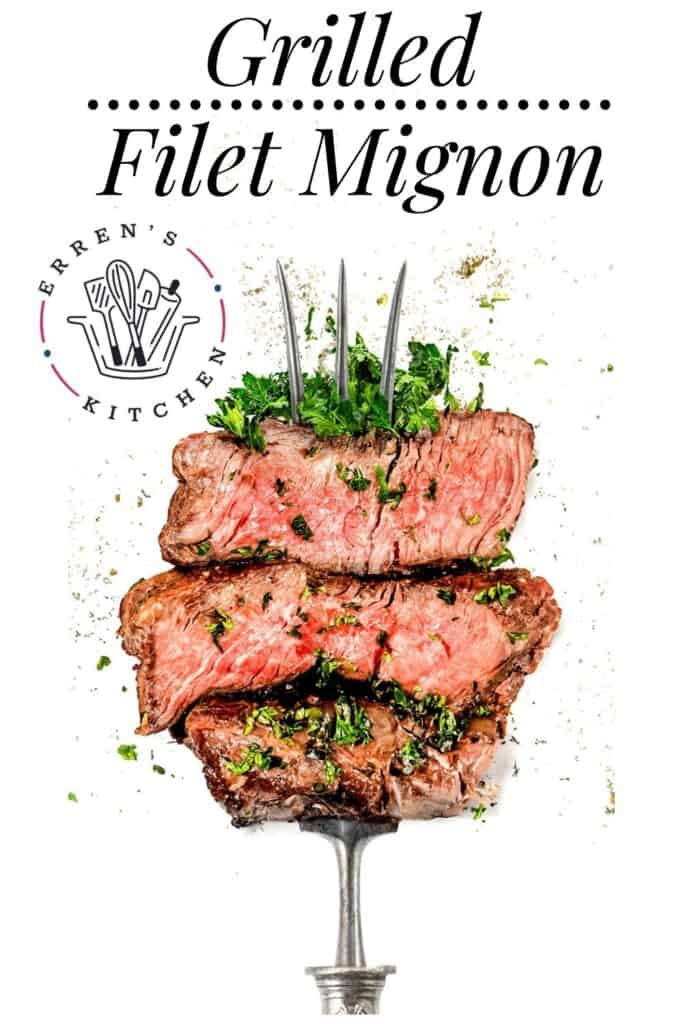
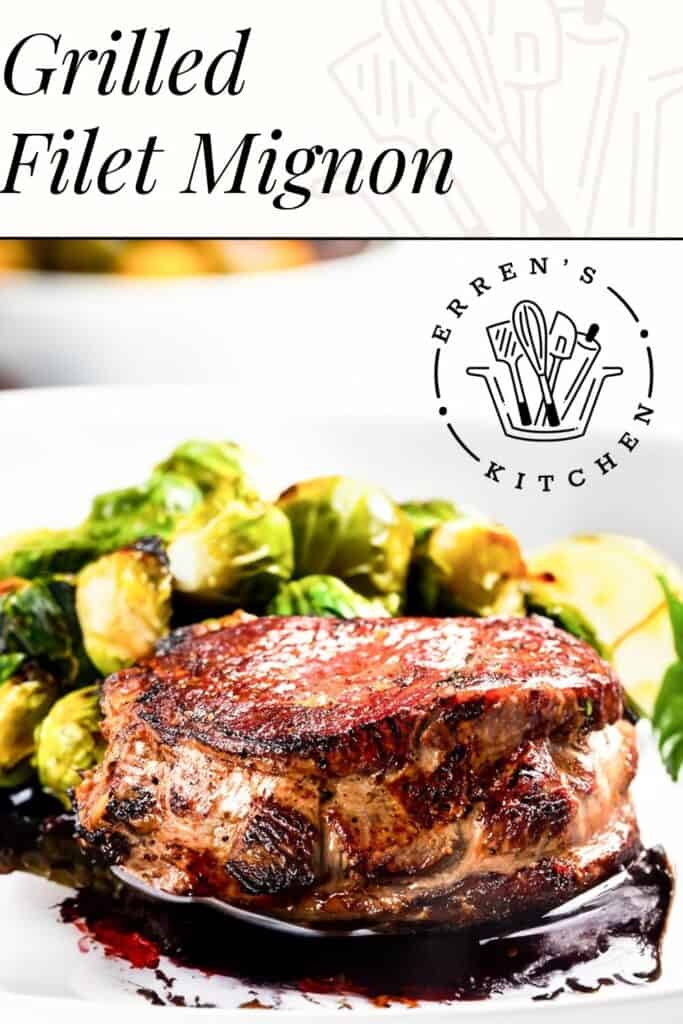
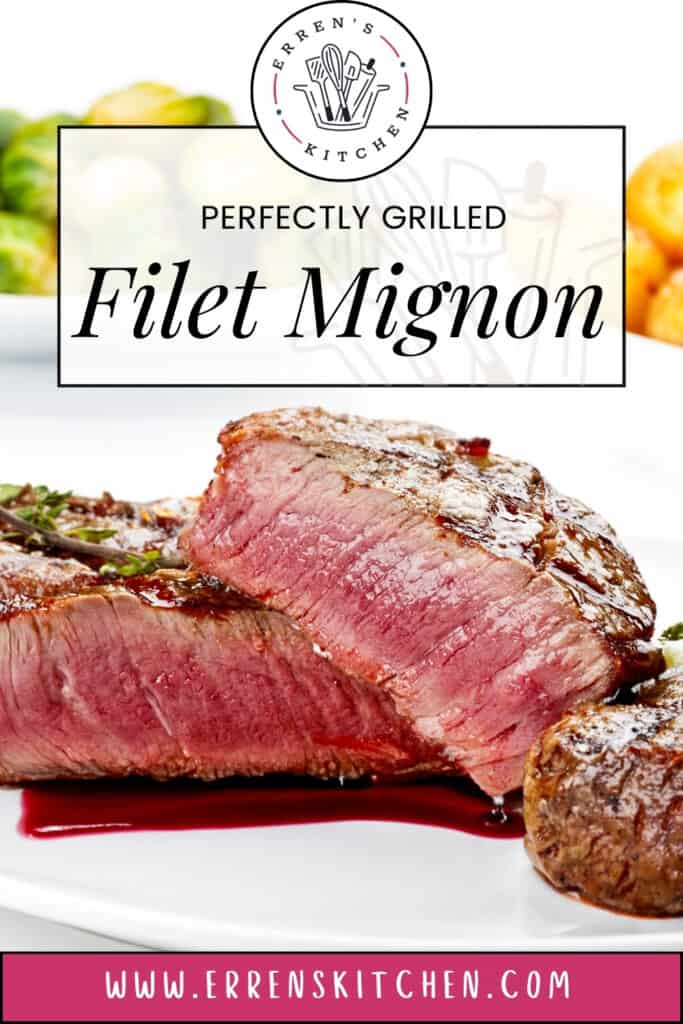



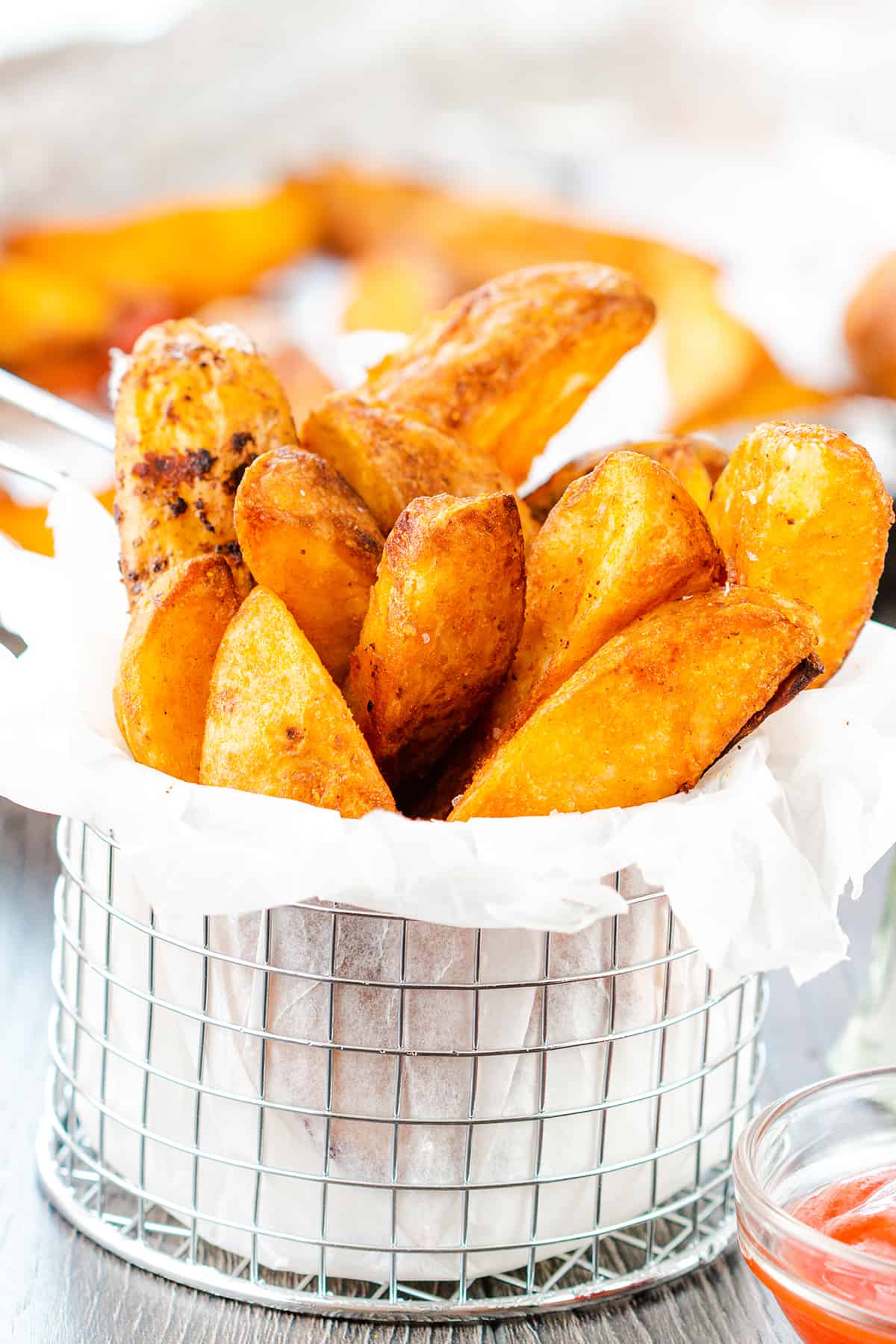
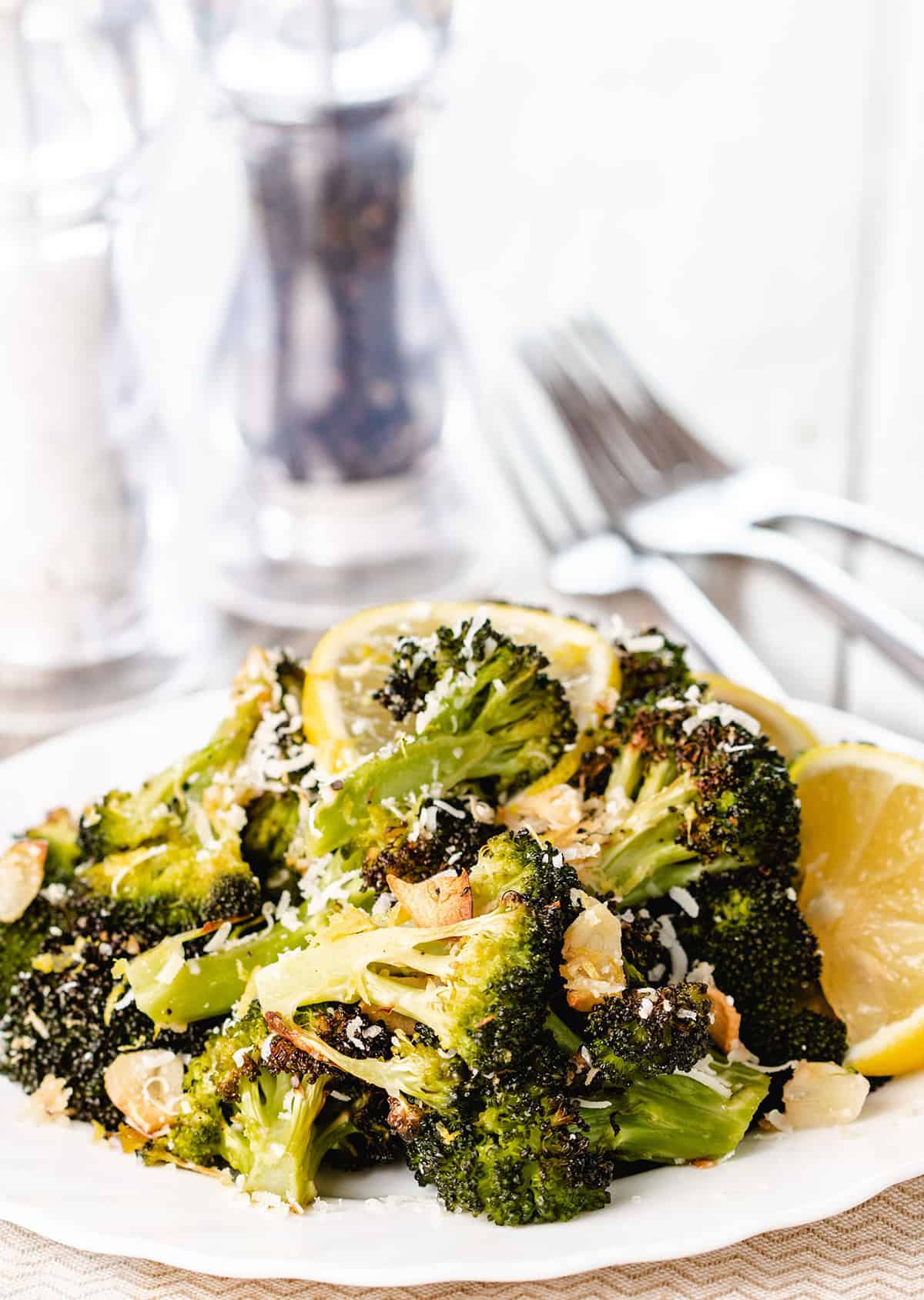
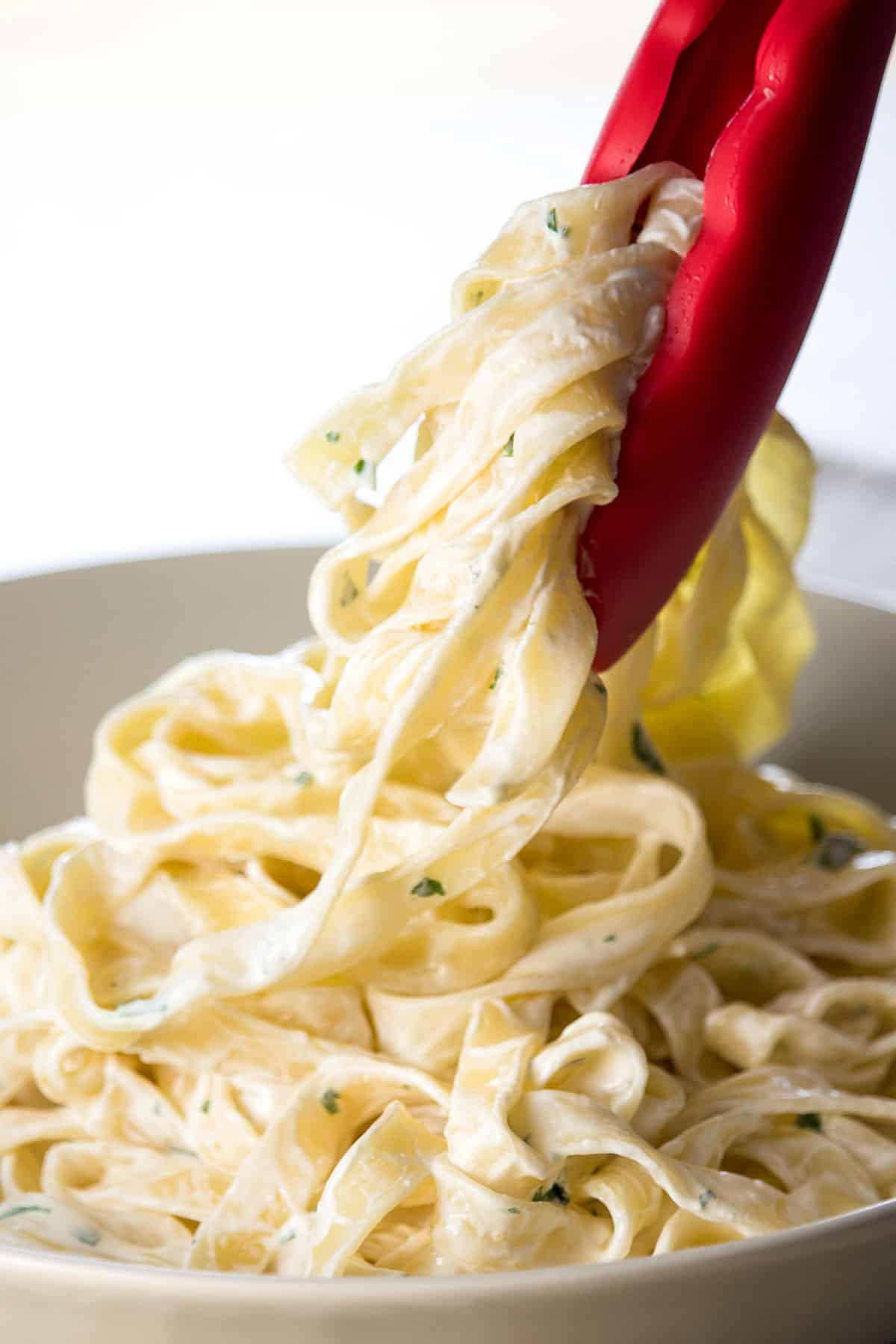
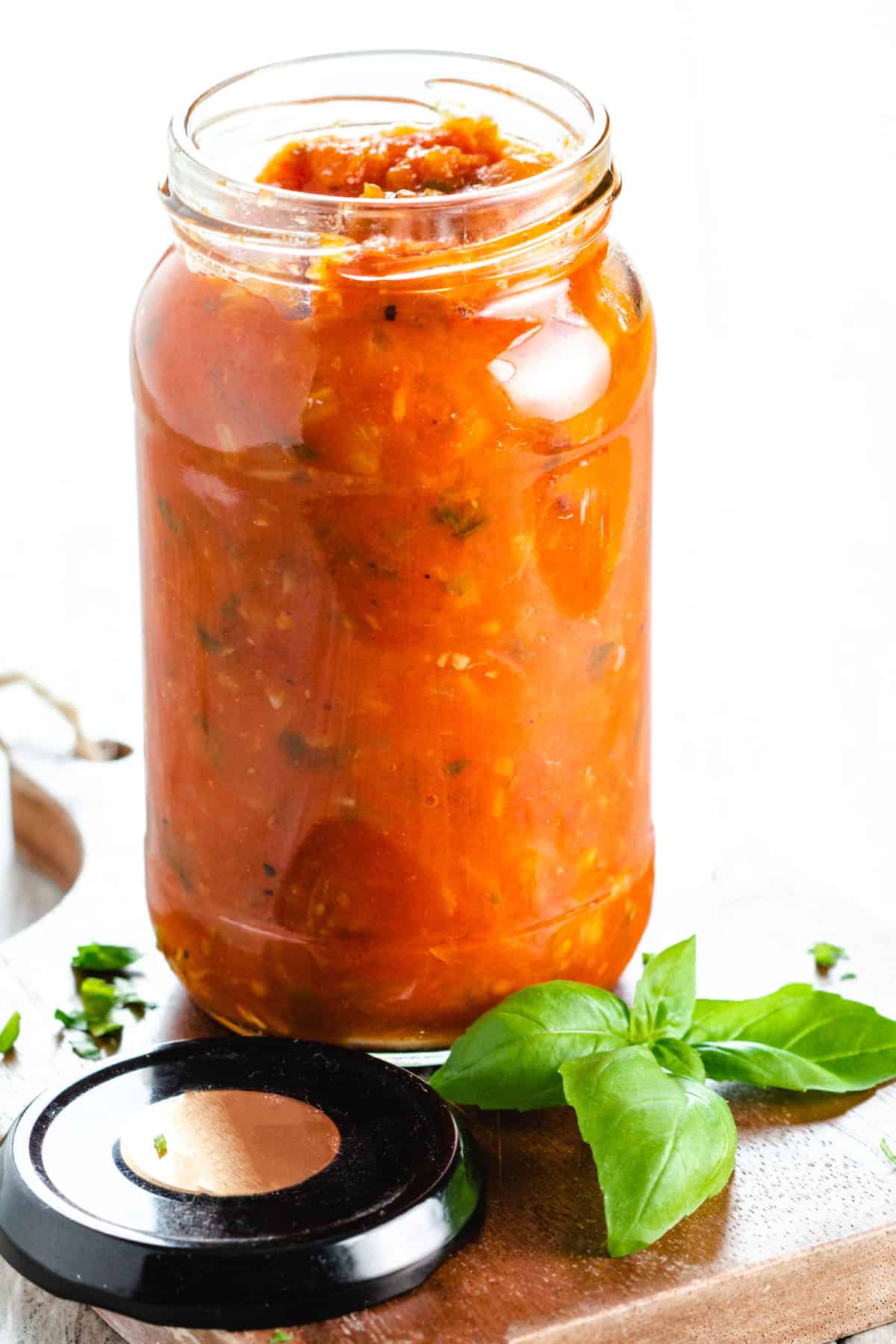
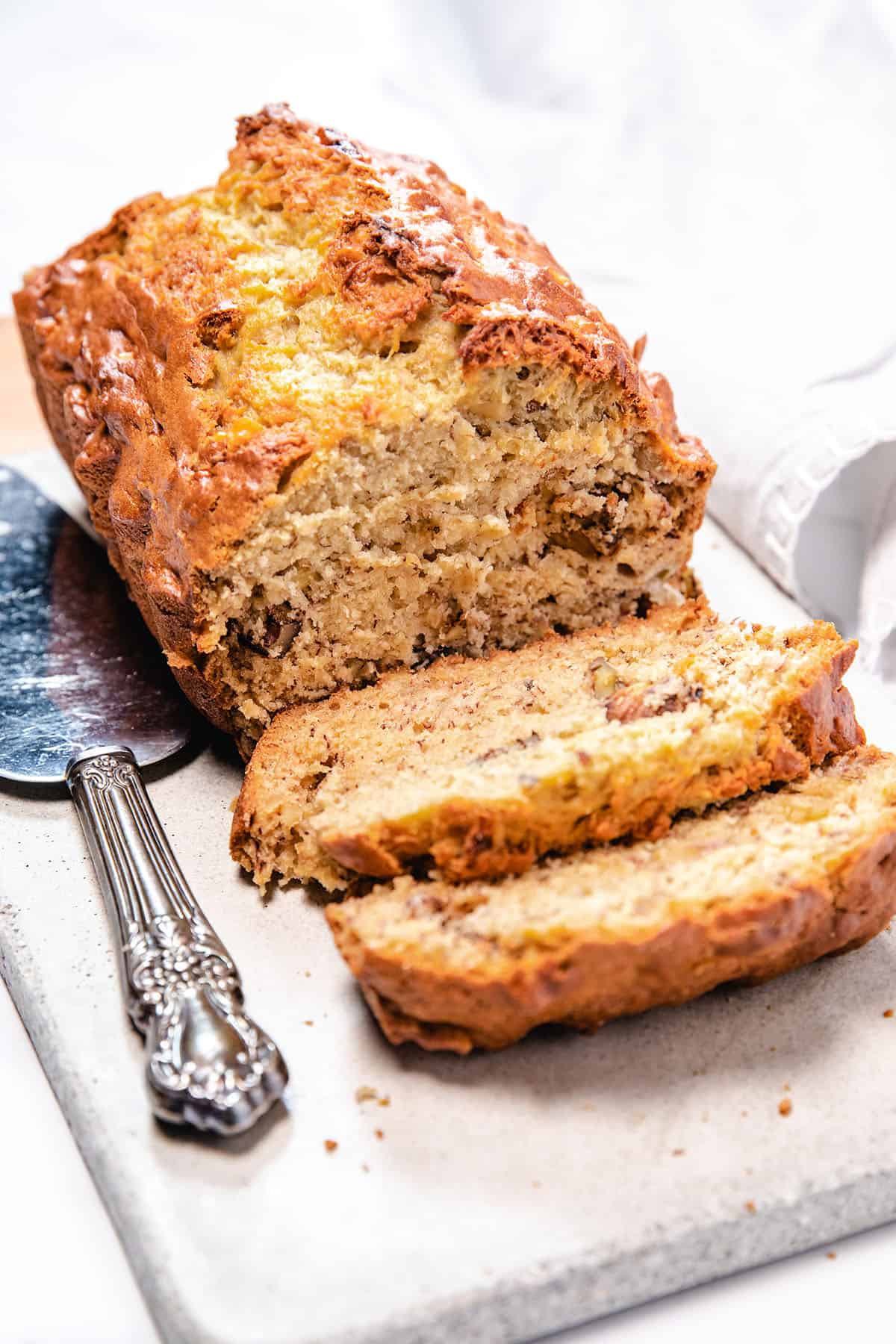
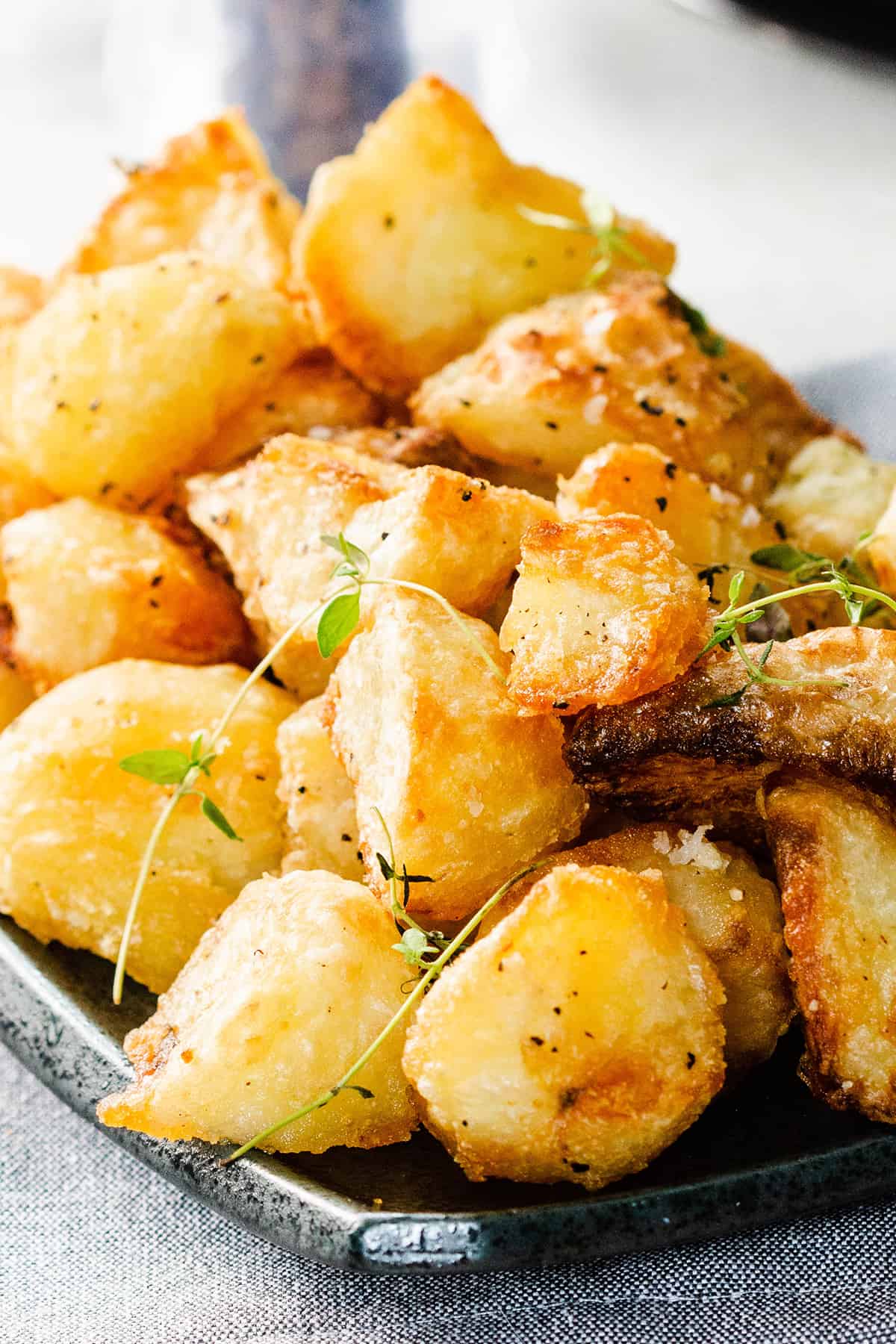
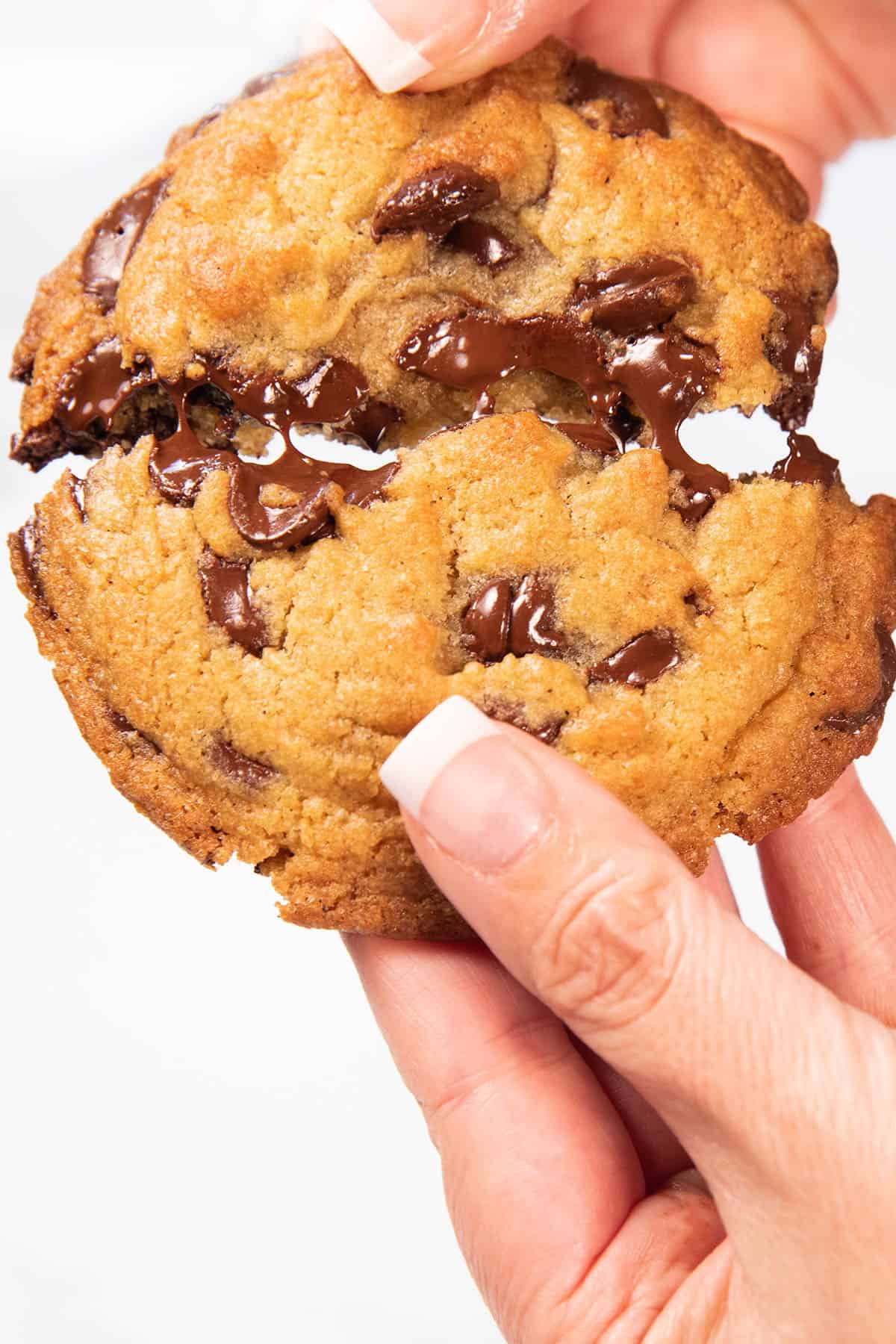
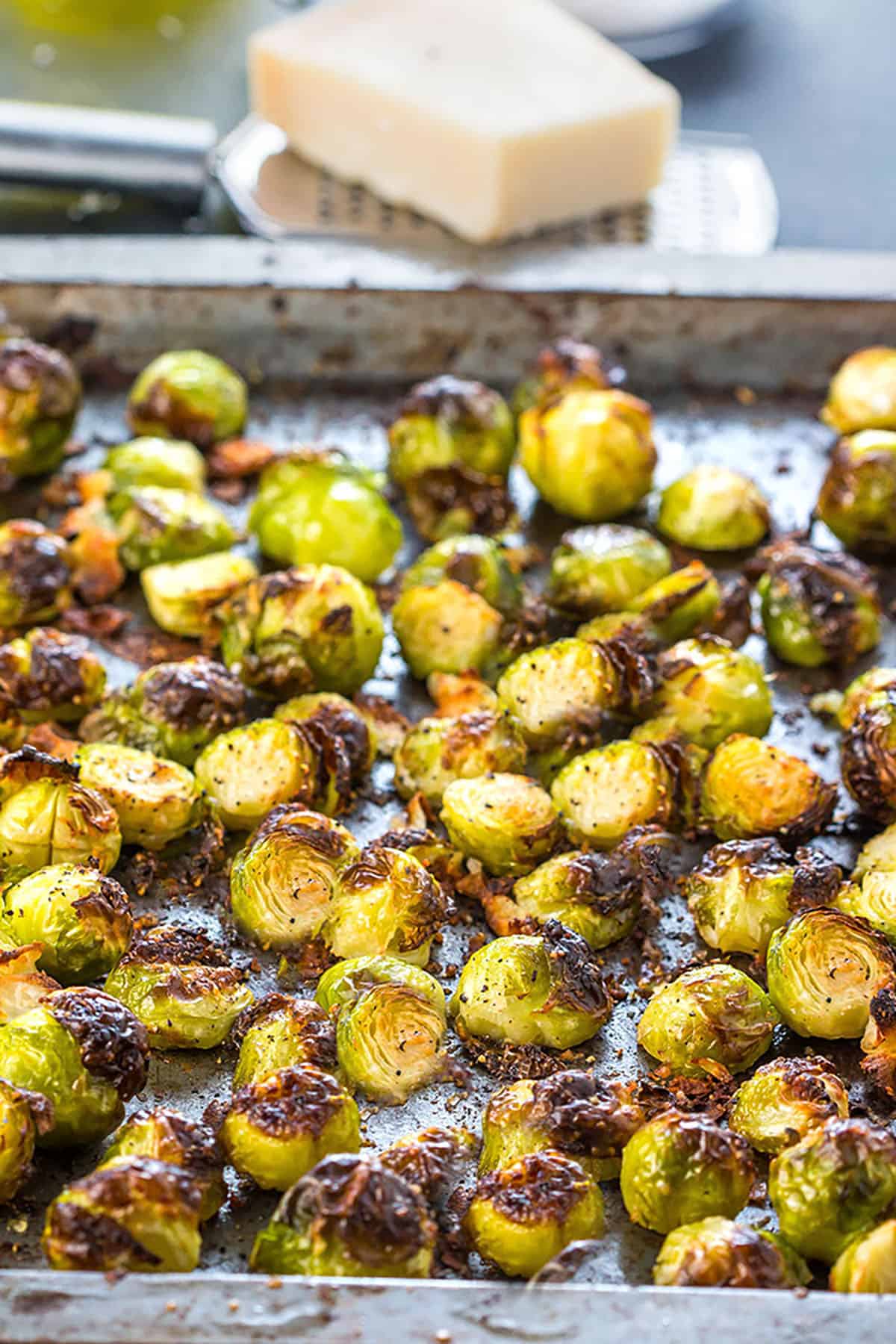
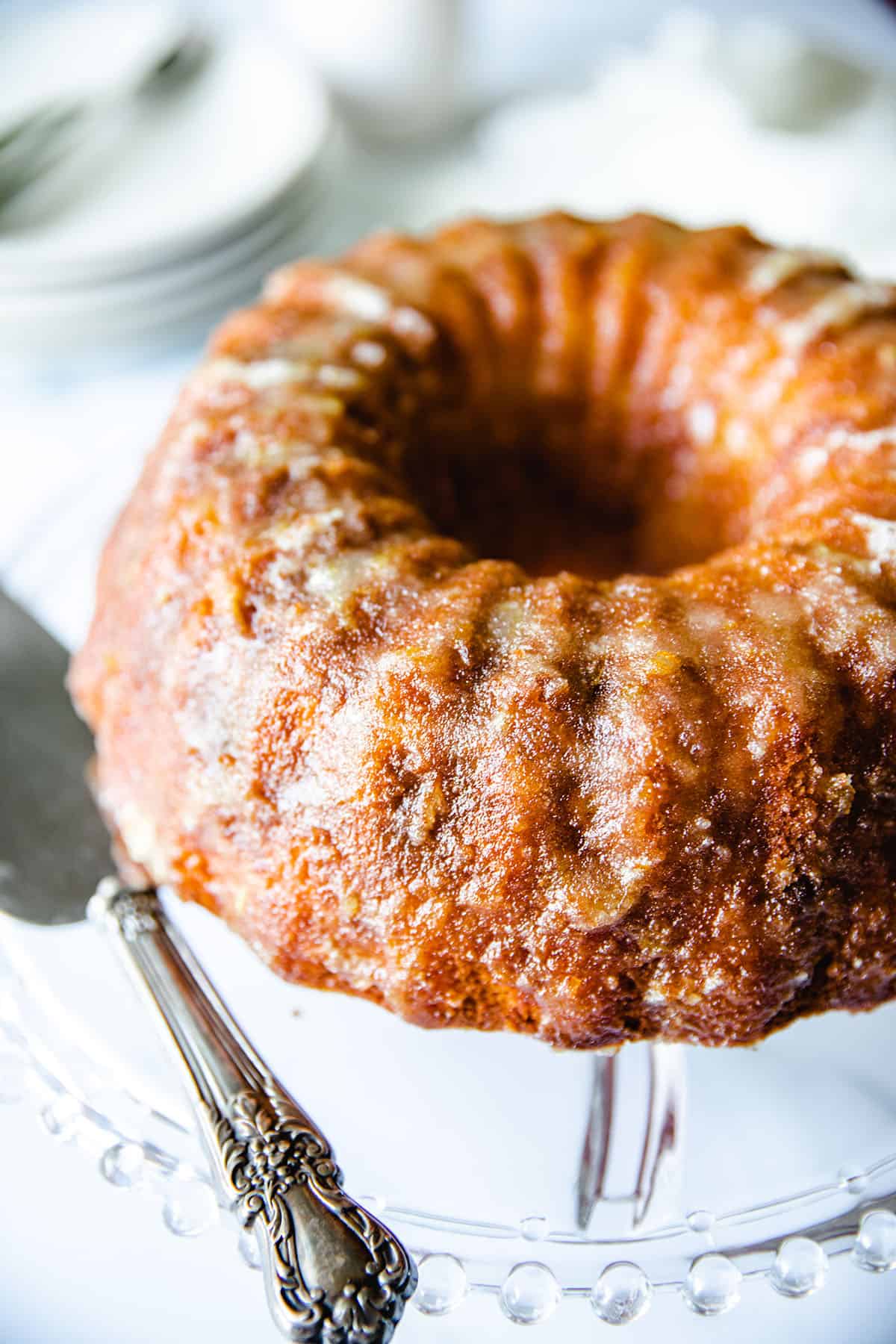
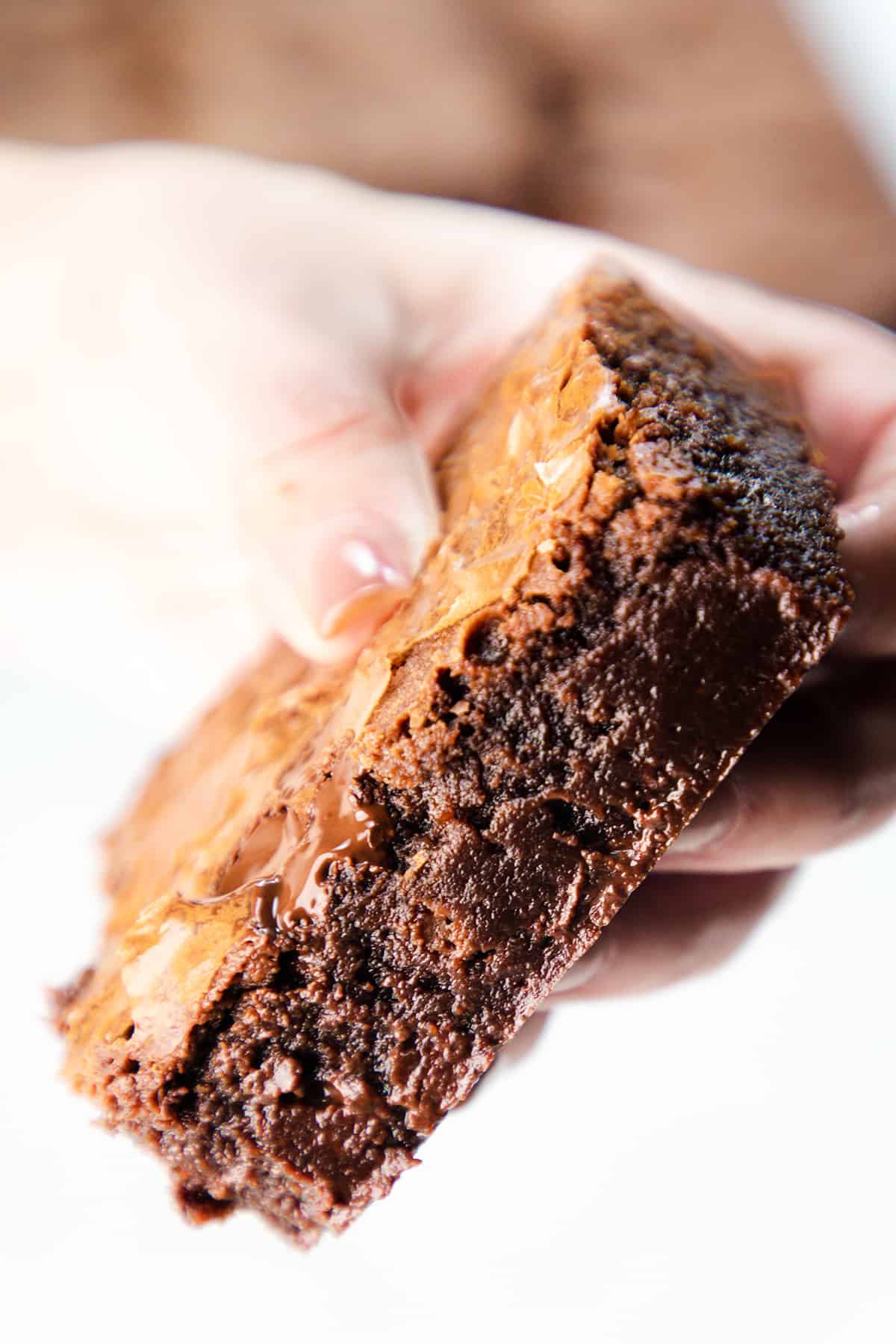

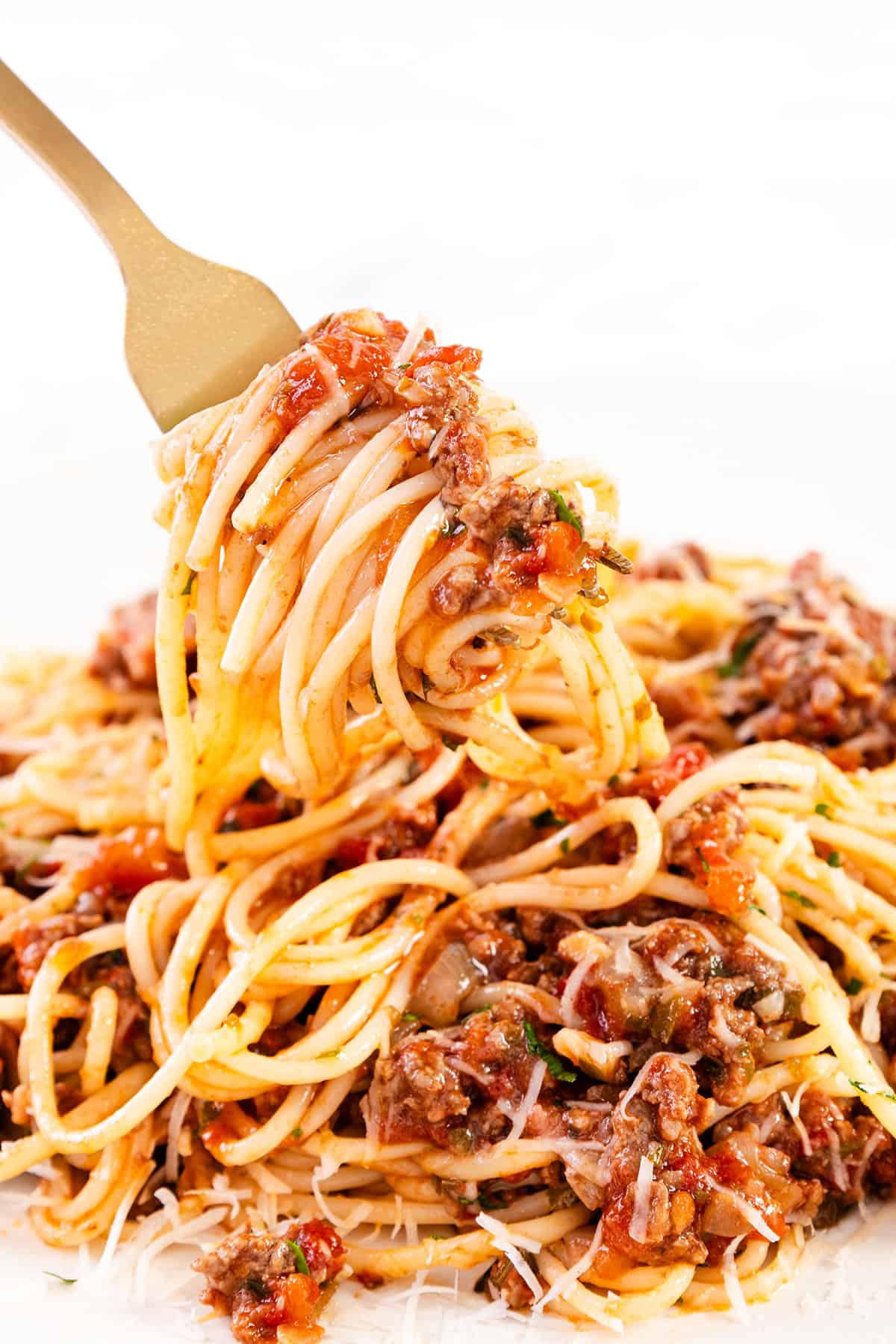
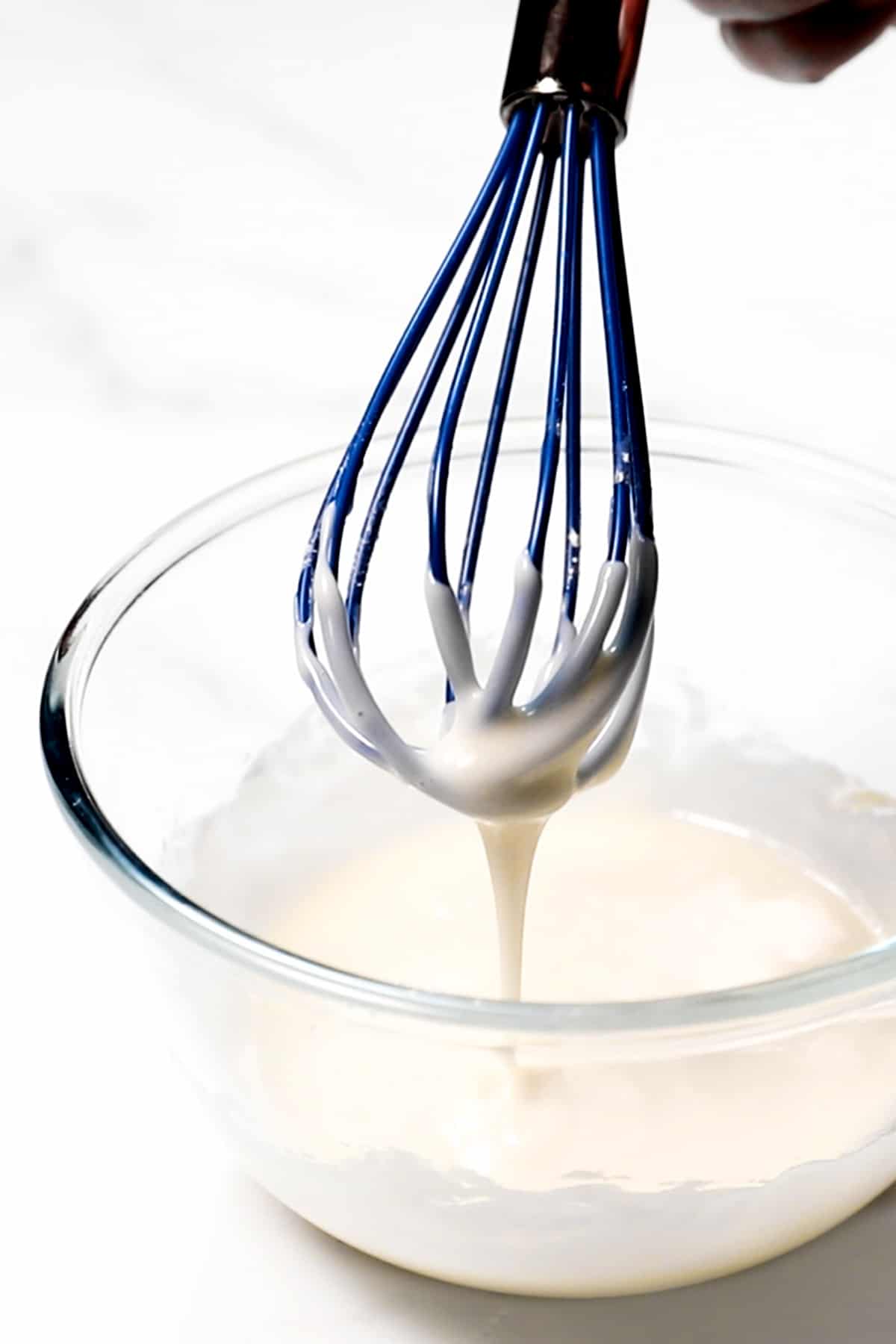

Leave a Reply